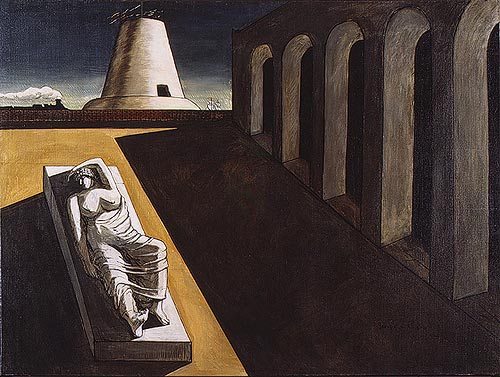A small but fascinating new exhibition, “Giorgio de Chirico and the Myth of Ariadne”, has just opened at the Estorick Collection of Modern Art. To mark the event today’s choice of picture is one of the highlights of the show: an early example of de Chirico’s work, titled Ariadne, which is owned by the Metropolitan Museum of Art in New York and only rarely placed on loan.
De Chirico was in his early twenties, a Greek emigre living in Paris, when he created this arresting image of a statue stranded in the empty stage-set of a city square. The deliberately inconsistent perspective and collage-like composition of Ariadne, as well as its dry and muted colours, suggest a certain affinity with Cubist painting, but the effect is very different. Each separate element of the picture has been made oppressively present to the eye. The foreshortened statue of the sleeping Ariadne, tip-tilted in space so that it seems almost to float in mid-air, has been laid out on its plinth like a body on a mortuary slab (an effect which recalls the Renaissance artist Mantegna’s famous recumbent, feet-first Dead Christ in Milan, a painting which de Chirico greatly admired). The dark arcade, which casts its dramatic shadow across more than half the scene, looms like the threat of a prison sentence. The tower on the horizon, pennants fluttering from its summit, bears an intriguing resemblance to a greatly enlarged upside-down flowerpot. To one side of it a black train chugs into view, starkly silhouetted against the green sky, while away to the right two sails of a distant ship complete the picture. De Chirico’s visual world is shot through with a distinct mood of paranoia: a place where everything surprises or shocks or otherwise insists on its own, startling singularity;...


